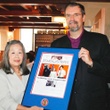AirVenture celebrates the Piper Cub's 75th birthday
OSHKOSH, Wis. — Of all the planes that fought World War II, from bombers to fighters to the German Luftwaffe's early jets, it was the lowly Piper Cub that recorded the final episode of air-to-air combat.
An L-4 Piper Cub, the military version of the popular J-3, was flying above a German observation plane when the two Americans inside the Piper swooped down, firing their .45-caliber pistols and forcing the German pilot to land.
Not bad for a small tail-dragger made of fabric and wood.
The first of roughly 20,000 Piper Cub J-3s was built 75 years ago and to celebrate the anniversary, EAA AirVenture has rolled out the red carpet. Scores of Piper Cubs have flown onto the sprawling grounds of the aviation convention in Oshkosh this week, with more than 60 taking part in a mass arrival at the start of AirVenture.
The honey-yellow planes adorned with black stripes and emblems on the tails featuring a cute bear cub holding up a red Piper Cub sign are parked in rows in the vintage aircraft area of AirVenture.
"Timing was everything. They were used before, during and after World War II," said Roger Meggers, a Piper Cub rebuilder from Montana who owns two Super Cubs. "Then Alaska opened up and it was like the pickup truck of Alaska."
An estimated four out of five World War II pilots in the U.S. learned to fly in a Piper Cub. After pilots returned home from the war, many bought Cubs for personal use, spending $1,000 to $2,500 on new planes, less for used ones.
Cubs continued to be a popular trainer with many pilots earning their wings between the late 1930s and into the mid-'60s. The J-3 was built between 1937 and 1947 followed by later versions such as the Super Cub.
There are still 5,500 airworthy Piper Cubs used by recreation pilots, bush pilots in Alaska and Canada, for traffic patrols, agriculture, wild game surveys and to tow banners over sports events. Pilots have "even shot grizzly bears with tranquilizer darts from a Super Cub," said Meggers.
"They're not flashy, they're a plain, practical airplane that was made very well," said Clyde Smith, who calls himself the Cub doctor. He's helped restore 250 Cubs, worked for the Piper company for 19 years and grew up in Lock Haven, Pa., home of the Piper Cub.
The plane is so simply constructed it's easy to manufacture parts, so there are plenty of replacements when something breaks or gets dinged, Smith said.
They're popular among recreation pilots who don't want to spend a lot for their planes — they cost $25,000 to $30,000.
"They're likely to go up in value. I had three people in here this morning asking if I knew anyone who was selling a Piper Cub," Smith said in the Vintage Aircraft hangar at AirVenture.
Michael Stimac, of Traverse City, Mich., bought a Clyde Smith-rebuilt 1946 J-3 nine years ago. He's flown it across Lake Michigan five times to visit AirVenture.
"I'll be sitting under the wing and you don't know how many people come up and say, 'I learned to fly in a Piper Cub and now I'm an airline captain,' " said Stimac as he stood in the shade of his J-3 on a hot, sunny day.
Stimac has owned 25 planes, but he loves his Cub best. They're such an easy plane to learn to fly, he explained, because they're gentle to handle. With the big wing and light load, it's almost like floating through the wind like a leaf rather than punching through the air like a dart.
But they're also more technically difficult to fly using a stick and landing with a tail dragging wheel as opposed to a steering wheel and more common tricycle landing gear.
"You don't drive it, you wear it," said Stimac.
Many Piper Cubs are passed down through generations of families.
Lyn Cate flew his 1946 J-3 from his Oregon home to Oshkosh. It's been in his family for three decades, purchased by his uncle, a commercial pilot who flew 747s.
"It's just a pleasure to fly," said Cate, noting that it's not exactly a great plane for cross-country trips, especially if you're in a hurry.
It took Cate nine days to fly his Piper Cub from Oregon to Wisconsin, a total of 31 hours flight time and 23 fuel stops. Still, he didn't want to miss the big 75th birthday gathering with others who love their Piper Cub just as much as he does.
"As you can see there's a real following," Cate said, pointing to the rows of yellow Piper Cubs lined up next to his plane. "It's sort of the standard for really small planes."










